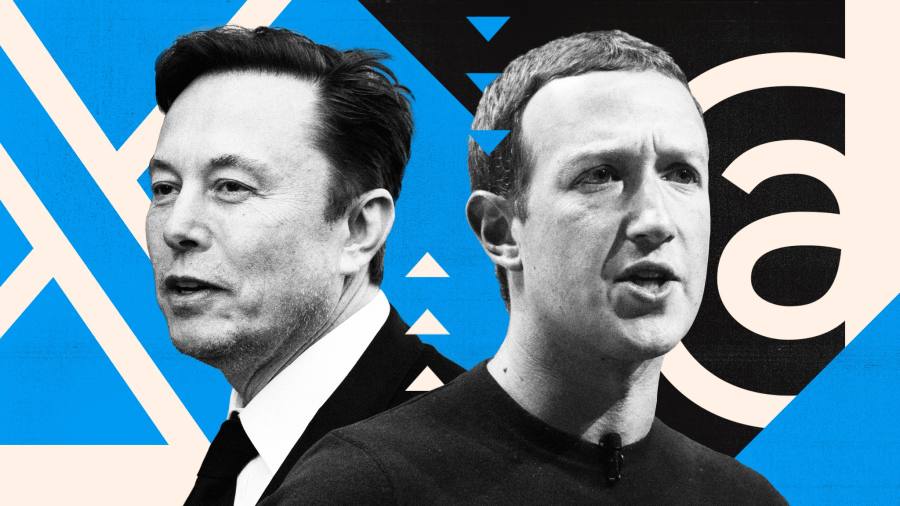Receive free Social Media updates
We’ll send you a myFT Daily Digest email rounding up the latest Social Media news every morning.
The writer’s latest book is ‘How to Disagree’
When Mark Zuckerberg first entered the ring against Elon Musk, it seemed as if he had delivered a knockout blow in the first round.
Zuckerberg’s company Meta conceived of Threads as a direct assault on Twitter (now X). Threads launched on July 5, after a breakneck rush to market, and did remarkably well, acquiring over 44mn daily active users at its peak. But now we’re in round two and the narrative has changed again. Threads has lost 80 per cent of those active users; it has about 8mn left.
Meta’s timing could hardly have been better. It arrived just after Musk’s team had infuriated Twitter’s approximately 400mn users by drastically — and possibly accidentally — limiting the number of posts they could see per day. Threads was hailed as the saviour of disgruntled tweeters.
There are many of them. Ever since Musk bought Twitter, now X, my timeline has been full of people complaining about how bad it is. Much of this is down to dislike of Musk, who glories in his role of pantomime villain. But it’s also because of how he and his team have set about disrupting the delicate ecosystem of the service, like ignorant colonial administrators knocking down homes and running roads through neighbourhoods.
The new management made it harder for users to see the tweets of those they chose to follow and harder to share links to other websites. They introduced more intrusive ads and allowed bots to flourish. They made random changes to the service seemingly on a whim and executed a clumsy rebranding. The user experience, always a mixture of delight and irritation, became more irritating and less delightful.
Most brands, managed as badly as this, would quickly be destroyed by rivals. But X is a service without viable competitors. Where else can you go to feel like you are part of a live, cacophonous public conversation about whatever is in the news? Prospective alternatives, like Mastodon and Bluesky, seem to require a degree in computer science to use. Clubhouse — well, that’s probably the first time you’ve seen it mentioned since everyone said it would replace Twitter.
Threads seemed different though. It is easy to get set up and start using it. Backed by Meta and linked to Instagram, it had scale pretty much immediately. It pitched itself as a kinder, gentler place, free of toxic rants and playground fights. Millions of Twitter users claimed a square of land there before returning to Twitter to tell everyone they had done so. But most of them never got around to fully emigrating.
Threads moved fast. Why didn’t it break Twitter? I think there are two main reasons. First, like Clubhouse and Substack before it, Threads misunderstood what it is that makes Twitter so compelling. People don’t visit Twitter despite the toxicity, but because of it. Most of us get bored during the day and crave a little low-stakes drama, and the essence of drama is conflict. As with smoking, the knowledge that you’re inhaling something unhealthy is, perversely, part of the appeal. Threads delivers on its promise, and that’s its problem.
The second, more fundamental reason is user inertia. Once a social media service has built a big userbase, the userbase itself becomes a reason for every user to stay. This is even more true of a Twitter-like social medium, which is driven by reactions to public events, than of more personal services such as Facebook or Instagram. You go there not just because your friends or acquaintances are there, but because everyone is there (or rather, the illusion of everyone; in reality only a minority of people use such services) and they’re all talking at once.
Crucially, this remains a powerful reason to visit even as the service deteriorates. Economists would call it a collective action problem: many or most users of X may be dissatisfied but until they all decide to leave at once, they will keep coming back. X is almost like an experiment to test the limits of this theory. Musk seems determined to prove he doesn’t need a competitor to drive him out of business, because he can do it himself. How bad can he make X before dissatisfaction exceeds inertia and enough users leave to render it defunct?
Threads, which is still refining its service, might yet become appealing enough to replace X as the dominant social app for high-information users. Alternatively, neither Threads nor Bluesky nor any other service will displace X, but a more varied ecology of similar services will emerge, appealing to different segments — liberal or conservative, high-drama or low-drama. For now, however, X staggers on, bruised and dazed but still the champ.
Read the full article here



